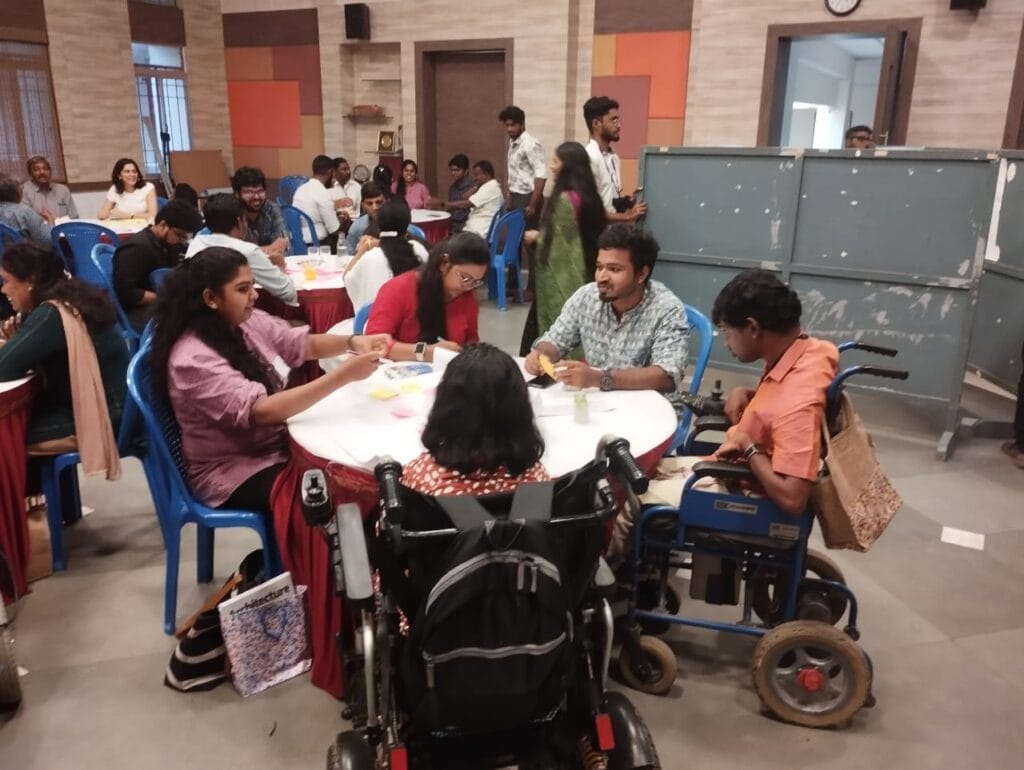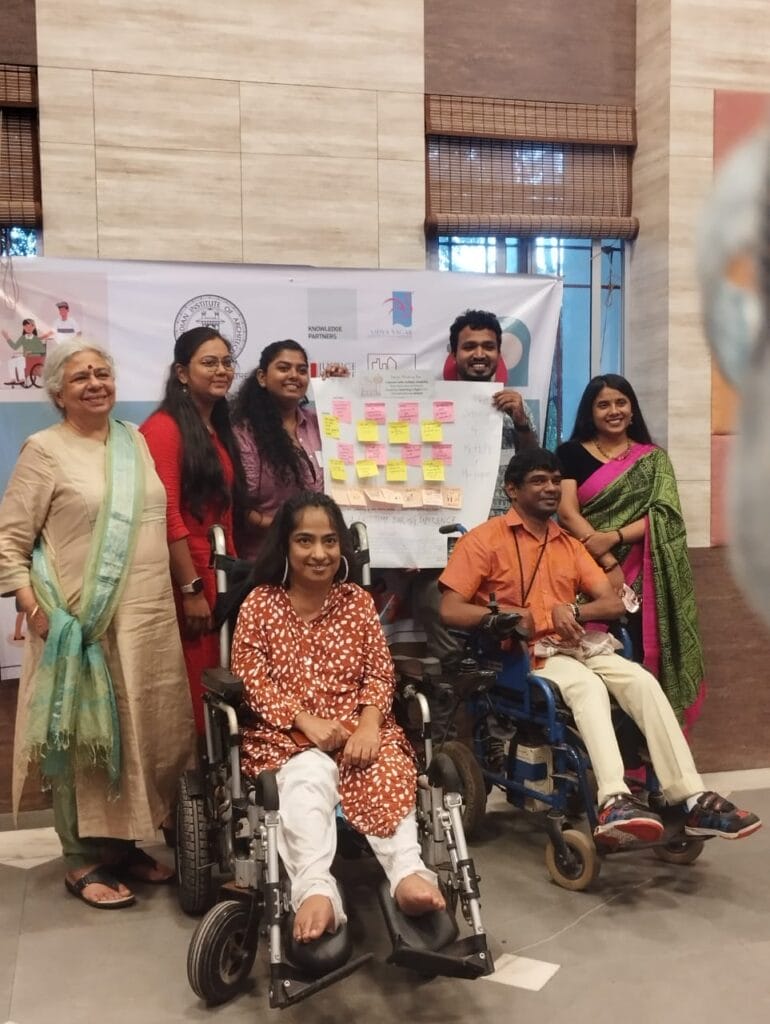Srivatsan Shankar, a photographer based in Chennai, was diagnosed with hearing loss at the age of six. Shankar faces many challenges in navigating daily life in Chennai, right from understanding announcements at railway stations to the use of opaque structures rather than glass in many spaces which impedes his ability to lip-read or receive visual cues.
At “Design for All,” an event that highlighted the imperative of creating a more inclusive and accessible Chennai, many such personal experiences and anecdotes came to the fore. The participants, who were architects and advocates within the Chennai community of people with disabilities, expressed their concerns at how the needs of such a substantial portion of the population have been consistently overlooked.
The message was clear – building accessible structures benefits everyone, and eventually aids not just people with disabilities. Temporary disabilities, such as a sprain or a fracture, can affect anyone. In such situations, the importance of navigating public spaces in cities like Chennai with ease becomes evident.
Different kinds of exclusion faced in Chennai
Roopa, a model and disability activist elaborates on her experience as a person of short stature. She finds it difficult to travel without assistance and has a caregiver since most public spaces are inaccessible for her needs. Door handles, light switches, and even public transportation seating are often designed for non-disabled individuals. From reaching for a book on a high shelf, operating a public restroom faucet, or even using an ATM becomes a daily challenge. This creates a sense of exclusion from everyday activities.
Sign language interpreter Nithya elaborates on how she learned signing from the hard-of-hearing community due to the unavailability of courses in Chennai. She says, “I work closely with the community and keep learning. I work as a freelancer and assist the community when they need me.”
Harishankar has multiple disabilities and low vision. He enjoys spending time with friends but faces physical barriers that hinder his social experiences. The steepness of ramps and the arrangement of tables in restaurants often make it challenging to navigate with his wheelchair. While he gets excited about going out, the reality of these accessibility issues can turn what should be an enjoyable outing into a struggle.
“When people with disabilities ask for accessibility, they do not mean assistance,” adds Harishankar. He explains the time his wheelchair was lifted along with him without his consent while he was at a restaurant. He reminds us that one of the most important etiquette is to never touch one’s mobility aid without consent.

Aditya Mahesh, a person with an intellectual disability and anxiety disorder, elaborates on his difficulties in public interactions. He expresses his concerns over his needs being dismissed in public spaces with a lack of understanding of multiple disabilities.
Travelling outside of India made individuals like Sandeep Paul, who manages arthritis with daily medication and uses a wheelchair, realise that he can very well experience public spaces, “It’s the system here that has a problem.”
When asked about how inaccessible situations are confronted, Sathish, a disability rights activist and wheelchair user, says, “It is hard that we are still fighting the system for all; we are asking for a design that will help all. For instance, when our friends plan a meeting, they have to shortlist a place that will be accessible for my wheelchair or will end up not including me in the meetup at all. It is bad for all.”
Read more: Can Universal Design be the magic bullet for an accessible Chennai?
Inclusive design the solution for Chennai
Inclusive design, often referred to as universal design, is about creating spaces accessible to everyone. It ensures that buildings and environments are accommodating to all individuals, including people with disabilities. This includes features such as ramps, braille signage, ample lighting for people with visual impairments, and even quiet spaces for those with sensory disabilities.

“While there is often a significant focus on locomotor and physical disabilities, it’s essential not to overlook those with disabilities like visual impairments, hard of hearing and invisible disabilities. Safety features like ramps and automated doors are vital for mobility. So does room arrangements, with circular layouts enhancing communication for those with hearing loss, and optimising acoustics by minimising noise reverberations.
Inevitably in Chennai’s infrastructure, a transformative shift is underway, marking a transition from the charity model to the social model of addressing accessibility.
Poonam Natarajan, Founder of Vidya Sagar Disability Community Organisation, highlights this change, emphasising a community-centric approach to creating accessible architecture.
Emphasising the need for independence and privacy in the lives of people with disabilities, Azeezh Rahman, a graduate of IIT Madras, an accessibility consultant and a person with visual impairment says, “I am all in for the technology and innovations that will make our lives easier.”
Read more: 2022 could be a watershed moment for disability rights in Chennai
Changes necessary in the landscape in Chennai
The Disability Act of 2016 mandates accessibility in public buildings, transportation, and digital platforms, promoting universal design principles. And yet, ableist structures are often built on the foundation of ignorance regarding these rights.
The story of Chennai’s Marina Beach ramp is another striking example of the struggles individuals with disabilities face when striving for accessibility. Ummul Khair, a disability rights activist and lawyer, recalls the arduous two-decade-long battle to make Marina Beach more accessible.
Architect Shivani shares Ummul’s reaction upon finally seeing the ramp installed: “This is what I waited for all this while.” The reality, however, was simple—a ramp made of wooden planks, a solution that, in hindsight, should not have taken two decades to implement.
Poonam points out the discrepancy between official guidelines specifying a suitable gradient for ramps, and yet in reality steeper designs are frequently encountered. It’s a situation that simply doesn’t make sense.
Sathish believes that accessibility should be built into structures from the beginning, rather than addressing deficiencies only after issues arise. This approach, he adds, would benefit everyone, making life easier for all and eliminating the need for reactive fixes.